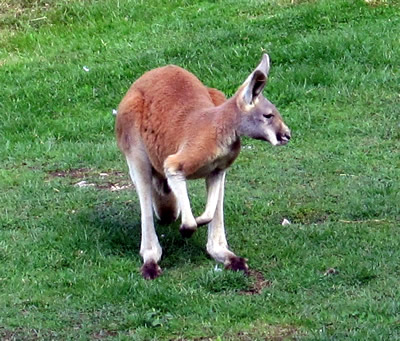Mammals

Facts about creatures
- Home
- Animal Classification
- Animal Habitats
- Amphibians
- Arthropods
- Bats
- Birds
- Carnivorans
- Cetaceans
- Chordates
- Crustaceans
- Dinosaurs
- Diprotodonts
- Elephants
- Fish
- Golden Mole
- Insects
- Lagomorphs
- Mammals
- Mammal Teeth
- Marsupial Mole
- Metamorphosis
- Mollusks
- Primates
- Reptiles
- Rodents
- Ruminants
- Soricomorphans
- Tenrec
- Tetrapods
- Vertebrates
Mammals
Mammals are vertebrates – animals with spines (backbones).
They belong to the group of tetrapods known as amniotes.
The first mammals appeared on Earth between about 200 and 250 million years ago.
Mammals share the following characteristics:
- They are warm blooded (endothermic). Birds are not mammals but they are also warm-blooded.
- All mammals have fur or hair during part or all of their lives.
- They have sweat glands
- Females have mammary glands (a type of sweat gland) which produce milk, a substance that is used to feed young.
- Mammals are heterodonts. This means that their teeth come in different shapes so that they can be used for different purposes, such as tearing, chewing or grinding.
- They have a middle ear, used for hearing, which contains three bones. This middle ear evolved from part of the jawbone of earlier animals.
- A mammal’s heart has four chambers.
- Mammals have a diaphragm, a sheet of muscle that separates the heart and lungs from the digestive organs and aids in breathing.
- The brains of mammals contain a region called the neocortex that is used for higher functions such as reasoning, problem solving and using language.
There are three different kinds of mammals: monotremes, marsupials (Metatheria) and placental mammals (Eutheria).
Monotremes
Monotremes are mammals that lay eggs (are oviparous).
The name “monotreme” means “one hole”. Monotremes use one hole, known as a cloaca, for reproduction and excretion.
Reptiles and birds also use a cloaca for their excretory and reproductive functions.
Only two kinds of monotreme are alive on Earth today. They are the platypus and the echidna, or spiny anteater. All of the monotremes that live in the wild live in either Australia or New Guinea.
Playtpuses and echidnas are poisonous.

Marsupials (Metatheria)
Marsupials are viviparous. This means that a female’s offspring begin to grow and develop inside her body before she gives birth to them.
While a developing marsupial is still inside its mother, it lives in an organ known as a uterus and gets its nutrients from an organ that resembles a yolk sac.
Mothers give birth when their babies are in a very early stage of development.
When a marsupial is born, it climbs into a pouch on its mother’s body. This pouch is known as a marsupium. The marsupium contains nipples through which milk is excreted.
The young marsupial lives in the pouch.
As it grows, it begins to venture outside of the pouch for short periods.
Eventually, it is able to live on its own, outside the pouch.
A baby marsupial is known as a joey.
There are between about 200 and 300 species of marsupial on Earth today.
Marsupials are only found in the wild in Australia and North and South America. There is only one North American marsupial – the opossum.
Other marsupials include kangaroos, wallabies, Tasmanian devils and koala bears.
Placental Mammals (Eutheria)
Placental mammals make up the most diverse group of mammals on Earth.
There are about 4000 to 5000 species of placental mammals, including Homo sapiens (human beings).
Placental mammals can be found on land, in water and in the air.
Like marsupials, placental mammals are viviparous. Young begin to develop inside a uterus within the mother’s body.
However, the offspring of placental mammals spend more time inside the uterus and are fully developed when they are born.
An organ called a placenta helps to nourish the developing placental mammal while it is inside its mother’s body. Nutrients, air and waste pass between the mother’s and the offspring’s blood supplies via the placenta.

Classification
Mammals and their closest extinct relatives belong to the clade Therapsida.
A clade is group of organisms with one common ancestor. All of the descendants of that ancestor belong to the clade.
The therapsids belong to the larger clade Synapsida.
A synapsid has one temporal fenestra (hole in the side of the skull) behind each eye socket or is descended from an amniote with one temporal fenestra behind each eye socket.
Mammals are the only living synapsids. All of the other synapsids that once lived on Earth are now extinct.
Biologists using the Linnaean system of classification sometimes consider extinct non-mammalian synapsids to be reptiles.
Synapsids were the first tetrapods to develop heterodont dentition. This means that they have teeth with different shapes that can perform different, specialized functions. Mammals are the only heterodonts alive today.